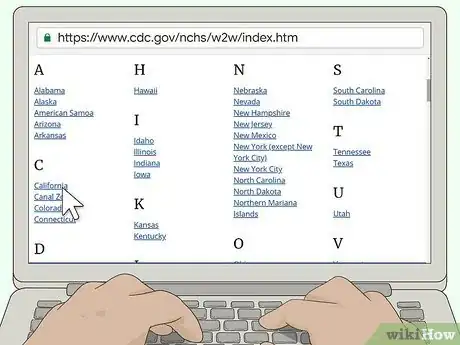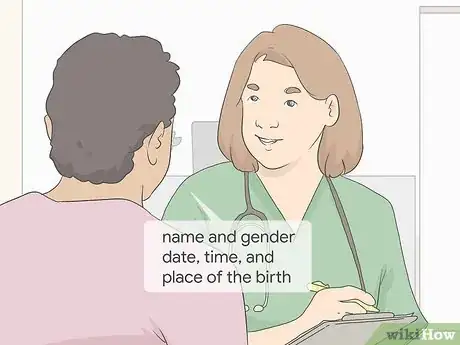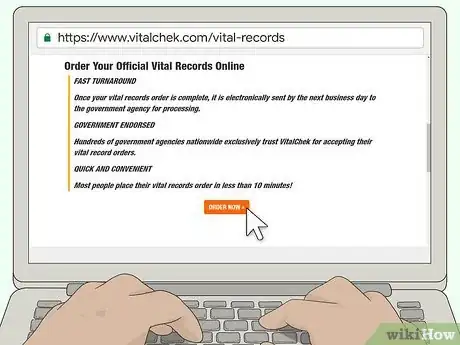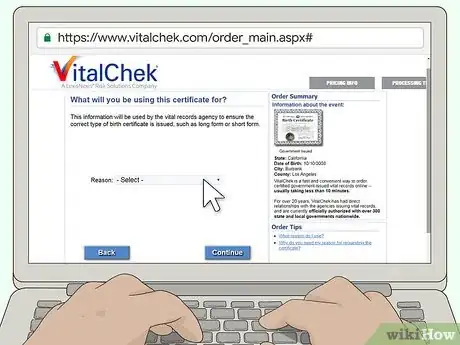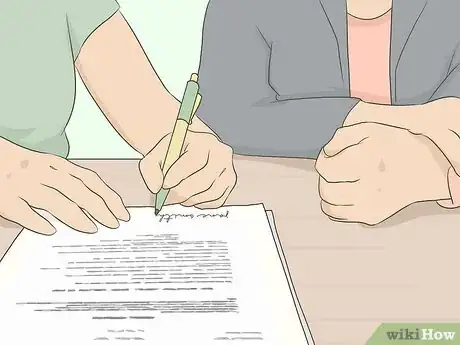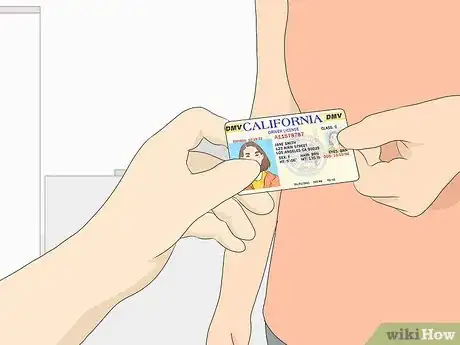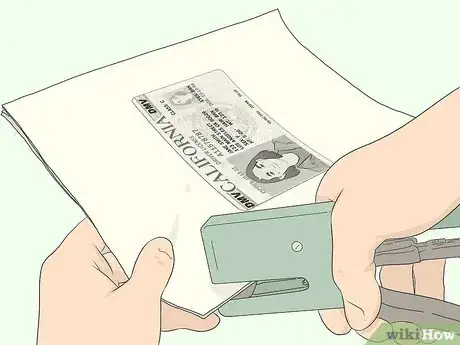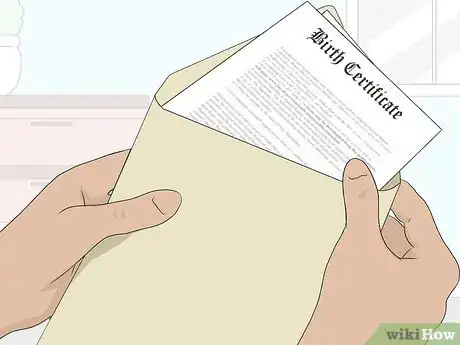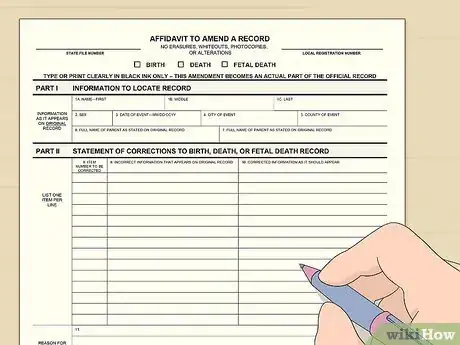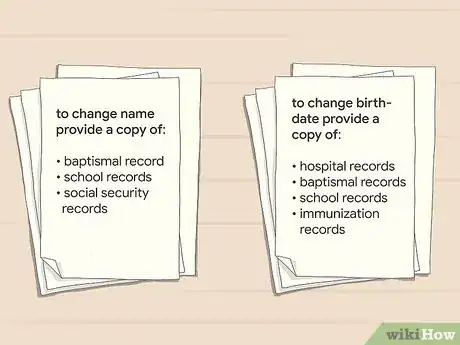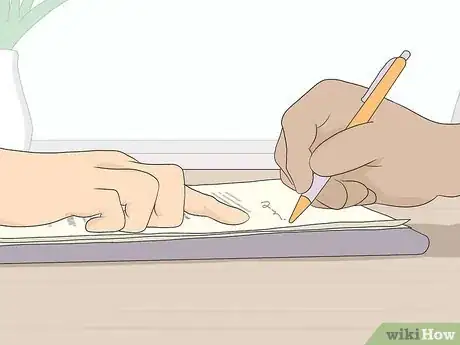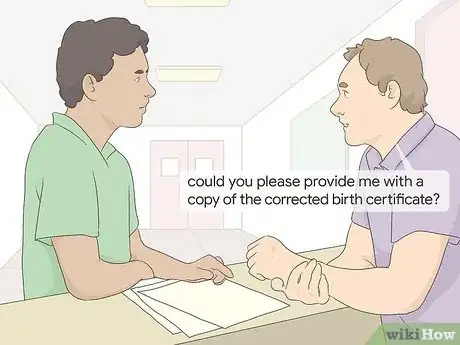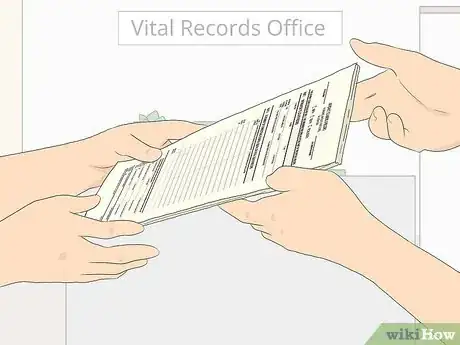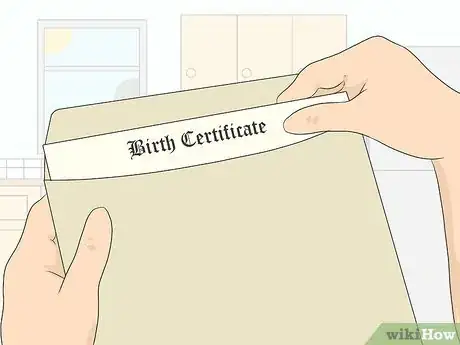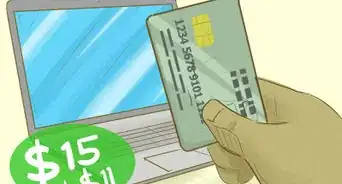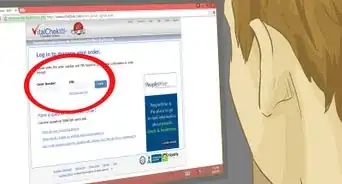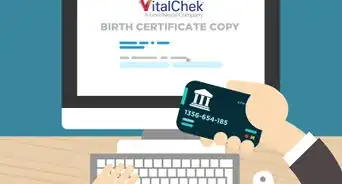This article was written by Jennifer Mueller, JD. Jennifer Mueller is an in-house legal expert at wikiHow. Jennifer reviews, fact-checks, and evaluates wikiHow's legal content to ensure thoroughness and accuracy. She received her JD from Indiana University Maurer School of Law in 2006.
There are 7 references cited in this article, which can be found at the bottom of the page.
This article has been viewed 12,807 times.
Every child born in the US needs a US birth certificate. Birth certificates are issued by the vital records office in the state where the child was born. If your child was born in the hospital, the hospital typically will get the information needed to report the birth to the state, although it may be weeks after the birth before you get a copy of the official birth certificate. You can also order additional copies of your child's birth certificate while they are under the age of 18, although, in most states, you must provide a legitimate reason for doing so.[1]
Steps
Reporting the Birth of a Newborn
-
1Coordinate with the hospital to complete the application. If your child is born in a hospital, the hospital typically gets information from both parents that is needed to complete the child's birth certificate. Much of this information may be gathered long before the child is actually born.[2]
- For example, the hospital may get information such as names, birth dates, and places of birth for each of the parents. However, the information about the actual child won't be completed until after the child is born.
- The hospital may have you fill out your state's application form for the birth certificate, or it may have its own form that it uses.
- If you use a midwife or an independent birthing center, they may report the birth to the vital records office for you or you may be responsible for reporting it yourself. Make sure you find out well before the birth if this is something you need to take care of.
-
2Get contact information for the correct vital records office. If your child is not born in a hospital, you may be responsible for reporting the birth to the vital records office yourself. Your state vital records office will have information on how to do that. Typically you will need to fill out a form similar to the one you would have filled out in the hospital.[3]
- The Centers for Disease Control and Prevention (CDC) has a list of vital records offices for each US state and territory available at https://www.cdc.gov/nchs/w2w/index.htm. Simply scroll down until you see the right one and click the link.
Tip: Most states require births to be reported within a few weeks after the actual birth of the child. Ask your state's vital records office about the deadline. It typically will be less than 30 days.
Advertisement -
3Provide information about the birth of your child. After your child is born, you must provide your child's name and gender along with the date, time, and place of the birth. This information will be included on the child's official birth certificate.[4]
- Depending on the type of birth certificate your state uses, you may also need to give an estimated gestational age for the child, the child's birth weight, or the child's Apgar score, if given. The Apgar test measures your child's physical condition after 5 minutes and again after 10 minutes.
- Some birth records also include information about the method of delivery and the presentation of the fetus. This information is normally included in the delivery record, completed by attending physicians, midwives, or nurses.
-
4Wait to receive your copy of the birth certificate. Once the application is submitted to the vital records office, it may take as long as 30 days for your child's birth to be registered and the birth certificate itself to be issued. Typically, you'll get a copy in the mail.[5]
- While the first copy of your child's birth certificate is usually free, you may have to pay a small fee (less than $20) for a certified copy, or for additional copies of the birth certificate.
Ordering a Physical Copy
-
1Fill out an application for a copy of your child's birth certificate. If you need a copy of your child's birth certificate, your state's vital records office will have an application you can fill out. You can get a paper form in person at the nearest vital records office. You may also be able to download a form from the office's website.[6]
- To find your state's vital records office, go to https://www.cdc.gov/nchs/w2w/index.htm and click on the name of the state or territory where your child was born.
- Most states also allow you to order a copy of your child's birth certificate online using the VitalChek service. As of 2019, this service is not available for births in Vermont or Wyoming. You'll pay an additional fee for this service, which varies from $20 to $50 depending on how fast you need the copy delivered to you. If you want to use this service, visit https://www.vitalchek.com/vital-records to get started.
-
2State the reason you are requesting a copy of the birth certificate. Birth certificates are not public record. States restrict the reasons you can get a copy of anyone's birth certificate other than your own.[7]
- Legitimate reasons to request a copy of your child's birth certificate include to get government identification documents, such as a driver's license or passport, to enroll your child in school, or to prove your child's age for sports or other extracurricular activities.
Tip: You typically can get a copy of your child's birth certificate as long as they are under 18. In some states, you may not even have to provide a reason. However, after the child turns 18, you may not be able to get a copy of their birth certificate without their written permission.
-
3Sign the form front of a notary if you're requesting a certified copy. A certified copy is stamped by an official in the vital records office as a real and true copy of your child's birth certificate. While you don't need a certified copy in most situations, you may need one if you are getting a passport for your child. Some states require requests of certified copies to be notarized.[8]
- If the state where your child was born requires certified copy requests to be notarized, you won't be able to order a certified copy using the VitalChek service. VitalChek will display a notice if certified copies aren't available.
- The notary will verify your identification and sign and stamp your form. This confirms for the vital records office that your signature is legitimate.
- There may be a notary in the vital records office. Call ahead to find out. Otherwise, you can find one at your bank or at the courthouse.
-
4Provide appropriate identification. You must show a valid government-issued photo ID, such as a driver's license or a passport, to prove that you are one of your child's parents and are entitled to a copy of their birth certificate. In some circumstances, you may need additional information, such as the results of a paternity test if your name doesn't appear on the child's birth certificate.[9]
- If you're ordering your child's birth certificate online, be prepared to provide information to validate your identity, such as a driver's license number or a passport number.
-
5Pay the fee for processing and shipping. If you order a copy of your child's birth certificate directly from the state vital records office, you will generally pay a fee of less than $40 for each copy. If you need a certified copy, you'll typically pay an additional charge (not more than another $15 to $20). The vital records office will mail the certificate to you when it's ready.[10]
- You can also pay for rush processing and rush delivery if you need the birth certificate quickly. These fees vary among states, but generally won't be more than $50. The vital records office will let you know how quickly the birth certificate can be delivered to you.
- If you order online through VitalChek, you also have rush processing and rush delivery options. In some cases, you may be able to get the birth certificate more quickly through VitalChek than if you order it through the vital records office directly.
- When ordering online, you'll typically need a major credit card. If you're ordering directly through your state's vital records office, call ahead or check the website to find out what methods of payment are accepted. Do not send cash through the mail.
-
6Submit your order with a copy of your identification. Along with your completed application, you must include a copy of both sides of a valid, government-issued photo ID. This could be your driver's license, military ID, or the photo page of your passport.[11]
- If you're submitting your order online, scan your ID or take a photo of it with your smartphone or a digital camera. Then attach that digital file to your request.
-
7Wait to receive your copy in the mail. Your state's vital records office will process your order and send it to you at the address you provide. Unless you chose rush processing and delivery, allow at least 2 weeks for your child's birth certificate to arrive.[12]
- Rush processing varies depending on the state. You'll seldom be able to get the birth certificate in less than 3 days, so plan ahead and order before you're going to need it.
- If you chose a method of delivery that required a signature, you will either need to be there to accept the delivery or you'll have to go to the post office to pick it up.
Making Changes or Corrections to a Birth Record
-
1Contact your state vital records office. If you discover that something on your child's birth certificate is incorrect, start the process to have the record fixed as soon as possible. Your state's vital records office will have a form you can fill out.[13]
- You can also request changes to a birth record if something happened after the birth that has the effect of altering the information on the birth certificate. This might happen if, for example, the child is adopted by a step-parent or expresses a gender identity different than the gender they were assigned at birth.
- If you don't have contact information for your state's vital records office, check at https://www.cdc.gov/nchs/w2w/index.htm.
-
2Fill out the required affidavit to request a correction. Typically, you'll complete a form that describes the incorrect or inaccurate information on the birth certificate and how that information should be changed.
- On the affidavit, you must state the reason for the correction. In some situations, this will be little more than a typo or clerical errors.
Tip: In limited circumstances, such as for adoption or gender reassignment, you may have to request a new birth certificate rather than requesting a change to the old one. The laws govern this vary by state, so ask at the vital records office.
-
3Provide documents to support your request. When you request a change or correction to a birth record, you must include official records that show the birth record is incorrect. The specific documents you'll need vary depending on the information you need to change.
- For example, if you need to change your child's first, middle, or last name as it appears on their birth certificate, you would need a copy of a baptismal record, school records, or Social Security records.
- If you need to change your child's birthdate, you could include a copy of hospital records, baptismal records, school records, or immunization records.
Tip: If you don't have documents that support the change to the birth certificate that you're requesting, you may need to get a court order. Talk to an attorney who specializes in family law to find out what you need to do.
-
4Sign your affidavit in the presence of a notary. Because affidavits are sworn statements signed under penalty of perjury, they generally must be signed in the presence of a notary. The notary verifies your identification and certifies that you are signing the document voluntarily and with knowledge of its contents.
- There may be a notary available at the vital records office. You can call ahead to find out. Notaries are also available at the courthouse and at most banks.
- The notary does not read the contents of your affidavit or verify the affidavit's substance in any way. They merely make sure that you are the person signing the document and that you are doing so of your own volition.
-
5Request a copy of the corrected birth certificate. When you request a change to a birth certificate, you typically don't get a copy of the corrected birth certificate automatically unless you order one. Expect to pay an additional fee for a copy of the corrected birth certificate, usually less than $40 unless you also need your order expedited.[14]
- Some states automatically provide a copy of the corrected birth certificate if you're merely correcting a typo or other mistake on a newborn's birth certificate less than 60 days after the birth.
- If there's no place on the affidavit form to request a copy, you can fill out a form through the vital records office to request a copy after the correction has been made.
-
6Submit your affidavit and supporting documents to the vital records office. Make a copy of your signed affidavit for your records before submitting it to the vital records office. Mail the original along with copies of your supporting documents. You can also take your paperwork to the vital records office in person.
- Most states charge a fee for corrections to a birth record, even if you don't want a copy of the corrected birth certificate. This fee is typically less than $20.
-
7Wait for your child's corrected birth certificate to arrive in the mail. If you ordered a copy of the corrected birth certificate, it will be mailed to you after the change has been processed. If your change couldn't be processed for any reason, you'll usually receive a notice explaining why the birth record couldn't be changed.[15]
- Expect your child's corrected birth certificate to arrive in the mail within 30 days of the date you submit your request. You typically cannot get changes or corrections expedited.
- If a court order or other documentation is required to complete your request, you may want to talk to a family law attorney to find out what you can do.
Warnings
- This article tells you how to get your child's birth certificate in the US. If you live in another country, or if your child was born in another country, the process may be different. Contact the vital records department where your child was born for more information.⧼thumbs_response⧽
References
- ↑ https://blog.vitalchek.com/vital-records/facts-get-babys-birth-certificate/
- ↑ https://blog.vitalchek.com/vital-records/facts-get-babys-birth-certificate/
- ↑ https://blog.vitalchek.com/vital-records/facts-get-babys-birth-certificate/
- ↑ https://www.cdc.gov/nchs/data/dvs/GuidetoCompleteFacilityWks.pdf
- ↑ https://blog.vitalchek.com/vital-records/facts-get-babys-birth-certificate/
- ↑ https://www.health.state.mn.us/people/vitalrecords/docs/bcappia.pdf
- ↑ http://www.sos.ne.gov/rules-and-regs/regsearch/Rules/Health_and_Human_Services_System/Title-174/Chapter-03.pdf
- ↑ https://www.health.state.mn.us/people/vitalrecords/docs/bcappia.pdf
- ↑ http://www.sos.ne.gov/rules-and-regs/regsearch/Rules/Health_and_Human_Services_System/Title-174/Chapter-03.pdf
- ↑ https://www.health.state.mn.us/people/vitalrecords/docs/bcappia.pdf
- ↑ https://www.nebraska.gov/hhs/birthcert/birthapp.php
- ↑ https://www.health.state.mn.us/people/vitalrecords/docs/bcappia.pdf
- ↑ http://www.idph.state.il.us/vitalrecords/births/Pages/default.htm
- ↑ https://www.health.pa.gov/topics/certificates/Pages/Birth-Certificates.aspx
- ↑ https://www.health.pa.gov/topics/certificates/Pages/Birth-Certificates.aspx

